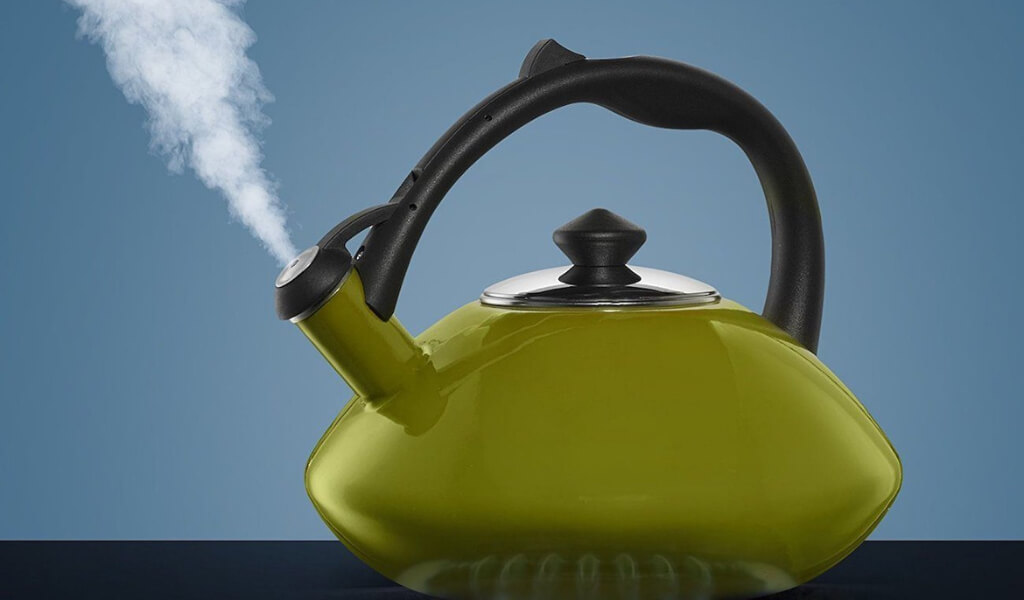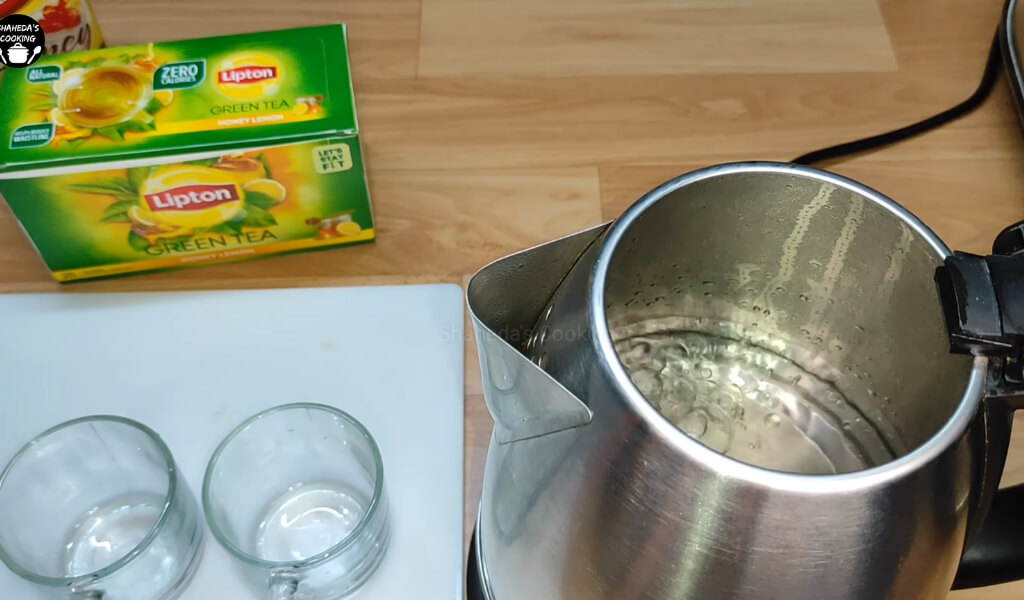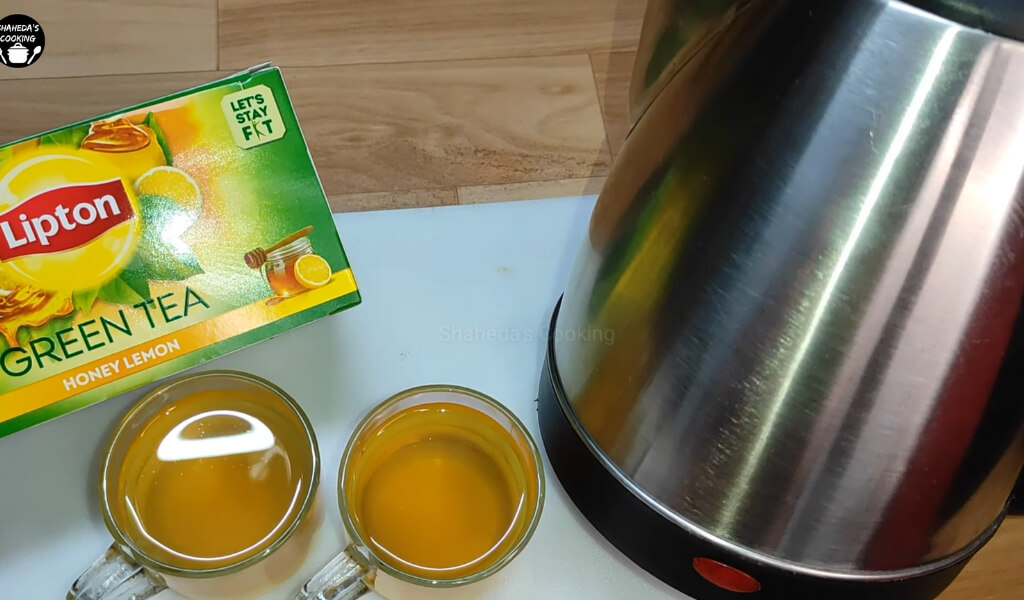Embarking on the journey of understanding how to make tea in a kettle reveals a unique charm surrounding the process.
The gentle bubbling of the water, the steeping of the tea leaves, it’s a ritual many of us cherish.
Beyond this delightful routine, brewing tea in a Kettle has numerous benefits, including improved flavor and the ability to control water temperature perfectly.
So, join me as we delve into the wonderful world of making tea in a Kettle.
How Does a Tea Kettle Work?
Each Kettle contains a metal coil that converts electrical energy into heat to warm the water inside. When the kettle is switched on, a high electric current passes through the coil, also known as the ‘heating element.
When you flick on your Kettle, a strong electrical current flows through a coil, or what’s known as a ‘heating element.’ This coil possesses a characteristic known as electrical resistance.
Now, this part is fascinating: this resistance changes the electrical energy into heat as the current passes through the coil. Then, this heat brings your water to that bubbling point, ready for brewing.
How to use a Tea Kettle
How to make tea in a kettle with Loose Tea or tea bags
As someone who cherishes their daily ritual of making tea with a Kettle, I’m thrilled to guide you through this delightful process.
Let’s dive deeper into each step, adding more insights and tips to enrich your tea-making experience with a kettle:
Step 1: Boil water in a Kettle
Here are the detailed guide:
- Clean the tea Kettle to ensure it is free from dirt.
- Fill it halfway to three-quarters with water.
- Heat the Kettle by setting the stove burner to high.
- Once the water boils, turn off the stove and take the Kettle off the hot burner.
The quality of water can greatly influence the taste of your tea. Once filled, turn on the Kettle and let the water heat.
Allowing the water to boil fully works best for black and herbal teas. For more delicate varieties like green or oolong tea, you want the water slightly cooler to avoid bitterness – stop just before it reaches a full boil.
Step 2: Prep the Pot
While the water heats, turn your attention to your cup or pot.
Here’s where you add your tea leaves or tea bag. I prefer loose-leaf tea, which expands the leaves and releases their full flavor. However, tea bags can offer convenience and a still lovely cup.

Step 3: Steep the Tea
Pour the hot water over your tea leaves or tea bag.
In this steeping process, water draws out the tea’s flavors, typically in 4-5 minutes, though you can adjust to your preference. Be cautious with green tea; steeping it for 2-3 minutes prevents bitterness.
Step 4: Discard the Tea Leaves or Bag
When your tea has steeped to your liking, it’s time to remove the tea leaves or bag. A simple filter can help if you’ve used loose leaves. Leaving them too long can over-extract the flavors and make your tea bitter.
Step 5: Sweeten If Desired
At this point, your tea is ready for any extras. Some like their tea plain, while others prefer a bit of sugar, honey, or a different sweetener.
Step 6: Serve
Finally, your perfectly brewed tea is ready to be enjoyed. Take a moment to appreciate the aroma before you take the first sip.
How to make tea by using an Electric Kettle with different types
| Black Tea |
This robust and flavorful tea requires boiling water. So, crank your electric Kettle to full boil (around 100°C or 212°F), add your black tea leaves to your teapot or cup, and pour over the boiling water. Allow the tea to steep for 3-5 minutes, depending on how strong you like it.
|
| Green Tea |
Green tea leaves are more delicate and don’t require fully boiling water. Aim for a temperature around 80°C or 176°F. Once your Kettle reaches this temperature, pour the water over your green tea leaves and let them steep for 2-3 minutes for a sweet, delicate flavor.
|
| Oolong Tea |
Oolong, the halfway point between black and green tea, likes a water temperature around 85-90°C or 185-194°F. Steep oolong tea leaves for about 3-5 minutes.
|
| White Tea |
White tea is the most delicate and needs a cooler temperature, about 75-80°C or 167-176°F. Steep the tea leaves for 4-5 minutes.
|
| Herbal Tea |
Most herbal teas (like chamomile or peppermint) also prefer boiling water. Pour boiling water over the herbal tea and steep for 5-7 minutes to extract all the flavors.
|
Keep in mind, these are only basic suggestions. You can customize the tea quantity, water temperature, and steeping duration to your preference.
Read More:
- 5 Main Difference Between Teapot and Kettle You Should Know
- Essential Types of Tea Kettles & Their Uses: Key things to know
How to Use Tea Kettle on Stove

So, here are the detailed steps on how to use an electric Kettle:
1. Clean Your Kettle
Even if your kettle is fresh from the store or just came out from hibernation in your kitchen cabinet, cleaning is key. This isn’t just tidiness; it also clears away any potential dust or chemical residue from the manufacturing process that could taint your tea’s taste.
2. Fill Your Kettle
Fill your kettle with ½ to ¾ of water for safety and efficiency. Less water risks over-boiling, while too much makes pouring tricky and can lead to spills. To enhance your tea’s flavor, opt for cold, filtered water instead of tap water, which may contain unwanted minerals and chemicals.
3. Heat It Up
Set your stove to high heat. It should take 5-10 minutes to boil, depending on your kettle’s size and how much water you’ve filled. If you’re using a whistling tea Kettle, listen for the whistle – that’s your signal that the water is boiling.
This feature is particularly handy if you’re the kind of person who multitasks and may forget a burner on. If you’re using a regular kettle, keep an eye out for a steady flow of steam from the spout and listen for a low rumbling – that’s your sign the water is ready.
Pour and Enjoy
Once the water is boiled, turn off the stove and carefully remove the kettle from the hot burner. Check the brewing instructions for your specific type of tea before pouring—different teas flourish at different water temperatures, and the right temperature can bring out the best flavors in your tea.
Can you put milk in a tea Kettle?
Certainly! You can heat milk in your kettle too! Remove any water from the kettle and pour in your desired milk. The only thing to remember is to be more careful when heating milk in a kettle than water. It’s generally recommended not to let the milk boil.
Here’s how I do it:
- Boil the Water: First, I fill the electric kettle with 1-2 cups of water, depending on how many servings I want. Once filled, I turn on the kettle and let the water boil.
- Add the Tea Leaves: I add in my chosen tea leaves as the water bubbles. The boiling water will start to extract the flavors from the leaves.
- Enhance the Flavor: For a touch of added complexity, I often crush a few cardamoms, cloves, or a small piece of ginger or cinnamon and add them to the boiling water. These spices elevate the overall taste of the milk tea.
- Add the Milk: I then pour in a cup of milk. Here’s a note: I always leave the lid open after adding the milk to prevent spillage.
- Wait and Strain: A few minutes later, I strain the mixture, catching all the leaves and spices, and pour the liquid into a cup.
- Sweeten If Desired: Lastly, add sugar, honey, or your preferred sweetener to taste.
In terms of advantages, this method saves time and dishes – it’s a one-pot solution. Plus, brewing the tea leaves and spices directly in the milk-water mix often results in a fuller flavor profile.
However, there are some disadvantages.
- The main one is cleaning. Milk can leave a residue in your kettle, which may require more thorough cleaning.
- It can also increase the risk of burning or overflowing if not watched carefully.
- Finally, not all electric kettles may be safe for boiling milk, so please ensure yours suits this purpose.
Besides milk, you can explore other enhancements too. Lemon brings a zesty kick to black tea, and a touch of honey offers natural sweetness and a floral note.
Consider the right Tea and Kettle
1. Choosing Your Tea
| Type of Tea |
Each type brings unique flavor and brewing requirements to your cup.
|
| Green Tea |
Known for its subtle and soothing notes, it requires a gentle hand in brewing.
|
| Black Tea |
Loved for its rich and bold flavors, it can withstand higher temperatures and longer steeping times.
|
| Herbal Teas |
These offer diverse flavors, from the calming notes of chamomile to the refreshing zest of peppermint.
|
2. Consider Your Kettle:
| Best Tea Kettle |
The quality of your kettle can enhance your brewing experience. Look for ones with built-in thermometers and variable temperature settings for precision brewing.
|
| Electric Kettle |
Electric kettles are a perfect choice if you seek convenience. They heat quickly and usually feature an automatic shut-off for safety.
|
Reasons for choosing a kettle
- You want to make tea the traditional way
- They appreciate the beauty of the jug
- You want the kettle to whistle to remind you when the water is ready
Reasons for choosing a kettle
- You want to heat the water in the shortest possible time
- Do you want a temperature-controlled kettle for specialty teas?
- You don’t have a stove
Remember, your tea brewing journey begins with these choices. So, take your time and select what works best for your preferences. Enjoy the process!
Tea Brewing with kettle: Tips and Techniques
Perfecting your tea-making skills involves being mindful of a few essential elements, many of which we’ve touched upon earlier in our tea journey.
| Steeping Time Matters |
Carefully timing your tea infusion can distinguish between a perfect and bitter brew.
|
| Watch the Temperature |
Adjusting your water temperature to match your type of tea is essential for optimal flavor extraction.
|
| Smooth Boiling is Ideal |
A rolling boil reached by your kettle provides the ideal hot water for most teas.
|
| Let It Cool for Delicate Teas |
A little cool-off time post-boil ensures a gentler brew for sensitive white or green teas.
|
| Measure for Precision |
If cooling, measure the temperature for that perfect brew moment every few minutes.
|
| Extras Make a Difference |
From milk to spices, your additions can elevate your tea to new flavor heights.
|
Why Should You Makes Tea In A Kettle
While I’ve shown you how to make tea in a kettle, it’s worth noting that traditionally, the kettle’s main function is to heat the water to the perfect temperature, not to brew it.
Whether you’re using a whistling kettle, an electric one, or a water boiler, it’s best to brew your tea in a teapot or mug. Pour the hot water from the kettle over the tea leaves in an infuser to ensure a great brew. Avoid making tea in a coffee maker, as it can lead to flavor interference and is generally not recommended.
However, life isn’t always perfect, and sometimes, you might find yourself in a situation where brewing tea directly in the kettle makes sense. Say you’re making tea for a large group and need more infusers or teapots.
Or, imagine you’re out camping with just a kettle and mugs and no tea filters in sight. These are the times when the rules can be slightly bent, and you can safely brew your tea directly in the kettle.
If you frequently find yourself in such situations, consider getting travel mugs with built-in tea strainers – a practical solution to keep your tea-making process straightforward. But, if you need to use your kettle for brewing, don’t worry!
Thanks for Spiritea Drinks
FAQs
How many tea bags do you put in a kettle?
Typically, you use one tea bag per cup of water in a kettle. However, add an extra tea bag if you prefer a stronger brew. Remember, the flavor also depends on the type of tea and the steeping time.
Do you make tea in a kettle or cup?
Tea is usually brewed in a cup or teapot, not directly in the kettle. The kettle primarily aims to heat the water, poured over the tea leaves or tea bag in a cup or teapot to steep.
Is it OK to make tea in an electric kettle?
It’s perfectly fine to heat water for tea in an electric kettle. However, like traditional kettles, the tea should be steeped in a cup or teapot for best results.
How long can tea sit in kettle?
It’s best to leave steeped tea in a kettle for less than an hour. Extended periods can lead to over-extraction, making the tea bitter, and it can also cool down, affecting the overall tea experience.
Is it OK to steep tea overnight?
Steeping tea overnight is generally not recommended, as it can lead to a bitter flavor due to over-extraction. For the best flavor, following the recommended steeping times for each specific type of tea is advisable.
Do you leave the water boiling when making tea?
No, you shouldn’t leave the water boiling when making tea. Once the water has reached the correct temperature, turn off the heat and pour the water over the tea to steep.
Should I leave water in my tea kettle?
It’s best not to leave water in your tea kettle after use. Emptying the kettle helps to prevent mineral deposits from building up, prolonging the lifespan of your kettle and ensuring the freshest taste for your tea.
Can I use a microwave instead of a kettle to make tea?
While it’s possible to heat water in a microwave for tea, a kettle—be it a stovetop or electric—is generally preferred. Kettles heat water more evenly and accurately, ensuring a better brew.
How often should I clean my tea kettle?
It’s best to clean your tea kettle at least once a month. Regular cleaning helps to remove mineral deposits and maintains the quality of your brewed tea.
Is it safe to leave my electric kettle plugged in?
While it’s generally safe to leave an electric kettle plugged in, unplugging it when not in use can save energy and provide an additional layer of safety in your kitchen.
I’m Shanna, creator of Spiritea Drinks. I’m all about teaching people to grow their own food, tea, cook what they harvest, and eat with the seasons.





